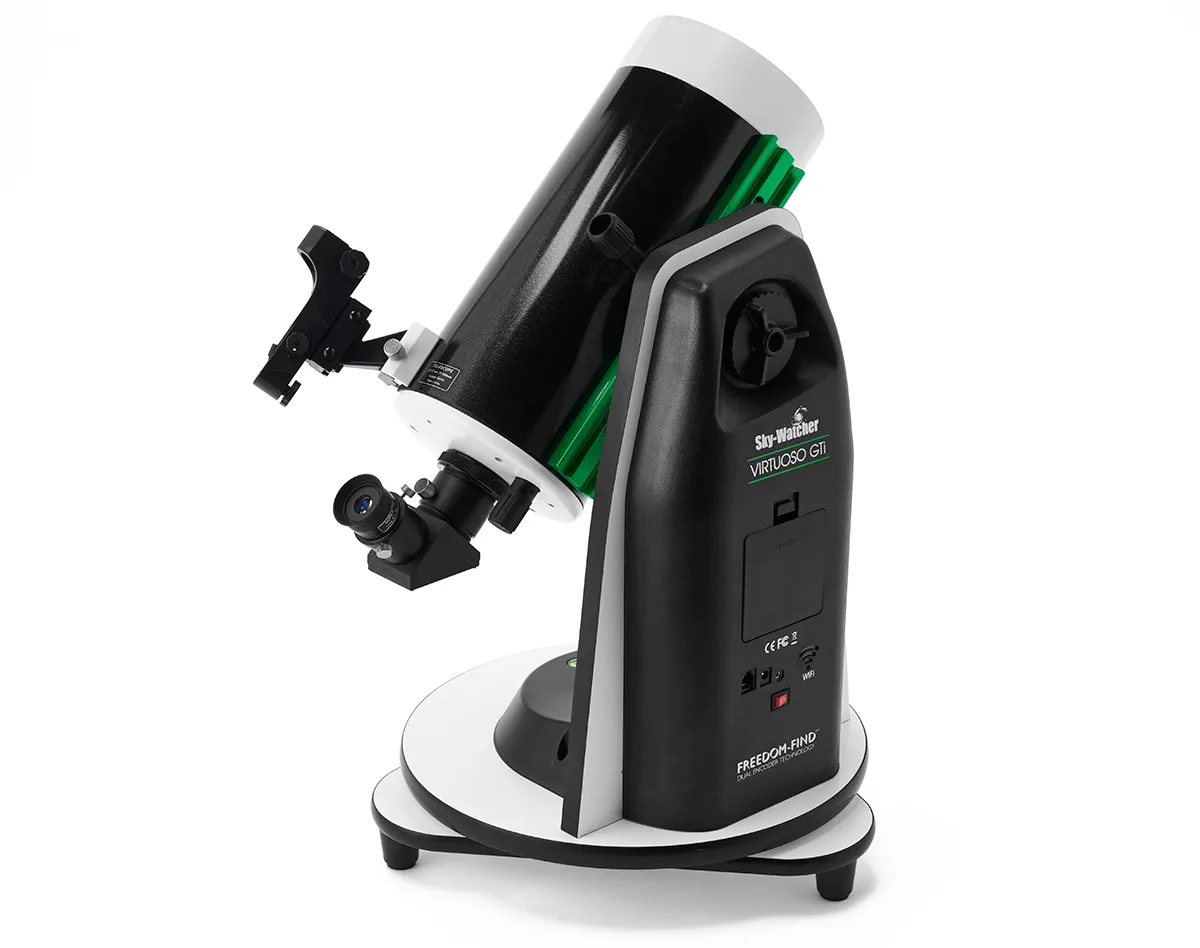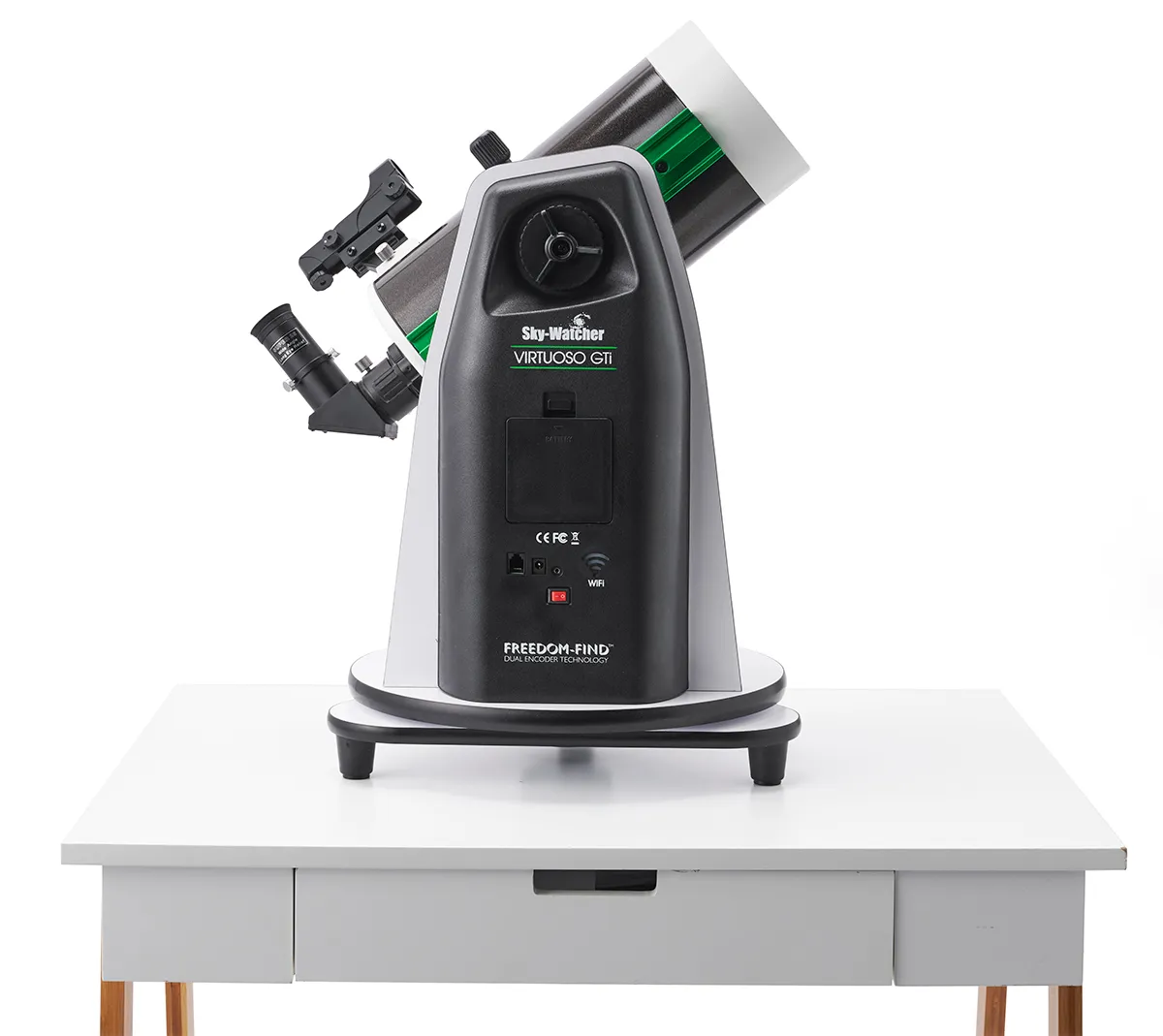Tabletop telescopes, such as the Sky-Watcher Skymax-127 Virtuoso GTi, have come to the fore because of their lightweight versatility.
As a compact telescope combined with a single-arm, Wi-Fi-controllable Go-To mount it offers to make the night sky available at the touch of an on-screen button.
The Skymax-127’s optical tube has a Maksutov-Cassegrain design that folds a 1,500mm-long light path into a tube that’s just 370mm long (excluding the star diagonal).
It has a 127mm-diameter primary mirror, and its long focal length (with a focal ratio of f/11.8) makes it ideal for lunar, planetary and double-star viewing, although you can also observe brighter deep-sky targets with it as well.
This telescope features in our lists of the best telescopes for beginners and best tabletop telescopes.

A red-dot finder allows for initial alignment and along with a star diagonal, there are 25mm and 10mm eyepieces, which give magnifications of 60x and 150x respectively.
The single-arm mount houses the electronics and includes a battery compartment for eight AA-size batteries, as well as ports for an optional power supply and camera, and an integrated Wi-Fi adaptor.
There’s also a hand-controller port if you don’t want to use your smartphone (the handset for this is sold separately).
The telescope’s base has a built-in spirit level and both axes can be locked and unlocked via clutches for free movement.
When combined with Sky-Watcher’s ‘Freedom-Find’ dual-encoder technology, this means you can do a star-alignment that will be retained after the clutches are unlocked.
- For more models like this, read our guide to the best tabletop telescopes.

The telescope is attached via a Vixen-style bar and an adaptor, and it can be easily removed for travelling.
The mount’s underside has a 3/8-inch thread so you can attach it to a tripod if that’s more convenient.
Being a tabletop-style mount you can use it manually, like a mini-Dobsonian mount, to enjoy the night sky without power.
However, it’s the integrated Wi-Fi adaptor that enables this scope to be controlled with a smartphone or tablet (either an Android or iOS system), and this allows you to use it anywhere.
It was easy to connect to the SynScan SSID to our iPhone XR (and iPad Pro) and, once the app has connected to the telescope, it lets you perform the star-alignment with either one, two or three stars, the brightest star, or north and level alignments.
We found that two and three-star alignments gave the best tracking and Go-To results in this test.

In terms of the views, Saturn presented crisp detail through the 25mm eyepiece – Saturn's rings were well defined, there was a hint of a northern belt and a good view of Titan.
The 10mm eyepiece revealed the Cassini Division in the rings, along with three more moons (Rhea, Tethys and Dione) and it gave a better view of the belt around the planet.
Jupiter was the next target and the views were gorgeous. The planet’s northern belt was clearly a brownish colour and much wider than the slimmer and fainter southern belt.
It was possible to make out hints of plume features with the 10mm eyepiece, as well as subtle hints of more belts.
All four Galilean moons were visible too. Our Moon was the target for the next test, a week later, and it almost filled the view through the 25mm eyepiece, presenting lots of detail to enjoy.
Switching to the 10mm allowed us to explore the lunar southern hemisphere in detail, taking in Clavius, Tycho, Maginus and other craters.
Next, we tested some of the better-known and brightest deep-sky targets: Bodes' Galaxy and the Cigar Galaxy. M81 appeared as a pale oval and M82 as a dappled sliver of light.
Both just fit in the field of view of the 25mm eyepiece, as did the Pleiades, M45.
Meanwhile, Albireo (Beta (β) Cygni) was resplendent with gold and pale-blue components, and with the 10mm eyepiece it was possible to split the ‘double double’ star in Lyra into all four parts.
Overall, the Sky-Watcher Skymax-127 Virtuoso GTi was a delight to use on a wide range of targets, and can be highly recommended.

Skymax-127 Virtuoso GTi's wi-fi control
The Virtuoso GTi single-arm tabletop mount houses a wireless network adaptor, so you can connect with a smartphone or tablet and control the mount.
This control is achieved by using the SynScan Pro app that can be downloaded for both Android and iOS devices.
Turn on the mount and it immediately broadcasts the wireless signal that you use to connect to your device.
Open the SynScan app and select ‘Connect’, and it’ll pick up the scope’s signal and make the connection.
You can then use the app to control the scope’s functions, such as performing star alignment and locating targets from the built-in lists available (note that Solar System objects are located under the ‘Stars’ menu).
The app worked well during this test and once connected, it also allows you to open planetarium apps, such as SkySafari, and to select ‘SkyWatcher SynScanLink’ in the telescope setup page to transfer control to even more targets.

Skymax-127 Virtuoso GTi 5 best features
Single-arm Go-To altaz mount
The single-arm mount is a table-top Dobsonian-style design with an integrated spirit level to help with setup, ports and a battery compartment. There’s a Vixen-style saddle for attaching the telescope and a retaining knob to secure it in place. Both axes can be loosened for manual adjustment.
Focuser and finder
The red-dot finder is useful for initial alignment, but it can fall victim to dew quite quickly. Focusing is achieved via a knob at the eyepiece end of the tube that pushes against the main mirror, moving it smoothly back and forth.
Optics
This Maksutov telescope has a 127mm primary mirror and a front corrector lens that also holds the secondary mirror. It has a focal length of 1,500mm and a focal ratio of f/11.8 – ideal for planetary and lunar viewing, but also for brighter deep-sky targets.
Eyepieces and diagonal
Two 1.25-inch eyepieces are supplied: a 25mm giving 60x magnification and a 10mm giving 150x magnification. They both have rubber eyecups and delivered good views of the test targets. A star diagonal allows for a more comfortable viewing angle, especially for targets high in the sky.
Ports and battery compartment
The arm of the mount houses a compartment for eight AA batteries (not supplied), the on-off switch, a power connector for an external 12V power pack, a snap camera port and a port for connecting an optional SynScan handset (although this shouldn’t be needed due to the Wi-Fi control).
Vital stats
- Price: £549
- Design: Maksutov-Cassegrain altaz Go-To Wi-Fi tabletop telescope
- Optics: 127mm (5-inch) primary mirror
- Focal length: 1,500mm, f/11.8
- Mount: Wi-Fi, computerised, altaz and single-arm
- Ports: Power connector, camera port, hand-controller port, integrated Wi-Fi adaptor, on-off switch
- Tracking rates: Sidereal, lunar, and solar; alignment free
- Extras: Red-dot finder, 25mm and 10mm 1.25-inch-fit eyepieces, spirit level
- Weight: 10kg (total kit weight)
- Supplier: Optical Vision Ltd
- Tel: 01359 244200
- www.opticalvision.co.uk
This review originally appeared in the January 2022 issue of BBC Sky at Night Magazine.
